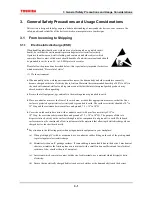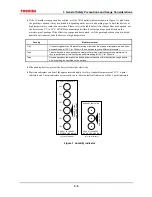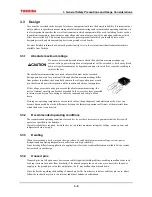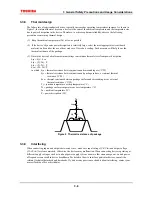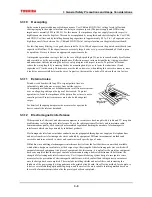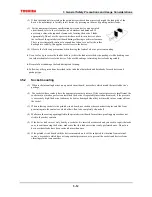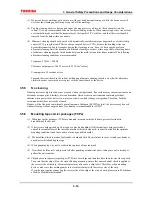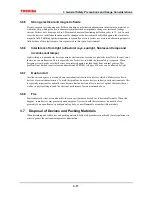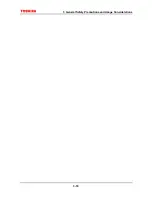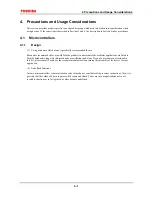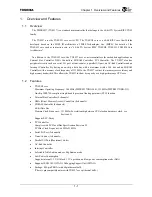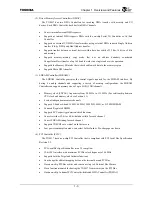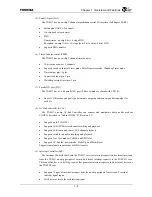
3 General Safety Precautions and Usage Considerations
3-15
3.5.7 Mounting
chips
Devices delivered in chip form tend to degrade or break under external forces much more easily than plastic-
packaged devices. Therefore, caution is required when handling this type of device.
(1) Mount devices in a properly prepared environment so that chip surfaces will not be exposed to polluted
ambient air or other polluted substances.
(2) When handling chips, be careful not to expose them to static electricity.
In particular, measures must be taken to prevent static damage during the mounting of chips. With this in
mind, Toshiba recommend mounting all peripheral parts first and then mounting chips last (after all other
components have been mounted).
(3) Make sure that PCBs (or any other kind of circuit board) on which chips are being mounted do not have
any chemical residues on them (such as the chemicals which were used for etching the PCBs).
(4) When mounting chips on a board, use the method of assembly that is most suitable for maintaining the
appropriate electrical, thermal and mechanical properties of the semiconductor devices used.
* For details of devices in chip form, refer to the relevant device’s individual datasheets.
3.5.8 Circuit
board
coating
When devices are to be used in equipment requiring a high degree of reliability or in extreme environments
(where moisture, corrosive gas or dust is present), circuit boards may be coated for protection. However, before
doing so, you must carefully consider the possible stress and contamination effects that may result and then
choose the coating resin which results in the minimum level of stress to the device.
3.5.9 Heat
sinks
(1) When attaching a heat sink to a device, be careful not to apply excessive force to the device in the process.
(2) When attaching a device to a heat sink by fixing it at two or more locations, evenly tighten all the screws in
stages (i.e. do not fully tighten one screw while the rest are still only loosely tightened). Finally, fully
tighten all the screws up to the specified torque.
(3) Drill holes for screws in the heat sink exactly as specified. Smooth the surface by
removing burrs and protrusions or indentations which might interfere with the
installation of any part of the device.
(4) A coating of silicone compound can be applied between the heat sink and the device
to improve heat conductivity. Be sure to apply the coating thinly and evenly; do not
use too much. Also, be sure to use a non-volatile compound, as volatile compounds
can crack after a time, causing the heat radiation properties of the heat sink to
deteriorate.
(5) If the device is housed in a plastic package, use caution when selecting the type of silicone compound to be
applied between the heat sink and the device. With some types, the base oil separates and penetrates the
plastic package, significantly reducing the useful life of the device.
Two recommended silicone compounds in which base oil separation is not a problem are YG6260 from
Toshiba Silicone.
(6) Heat-sink-equipped devices can become very hot during operation. Do not touch them, or you may sustain
a burn.
Summary of Contents for TX49 TMPR4937
Page 1: ...64 Bit TX System RISC TX49 Family TMPR4937 Rev 2 0 ...
Page 4: ......
Page 13: ...Table of Contents ix TMPR4937 Revision History 1 ...
Page 14: ...Table of Contents x ...
Page 15: ...Handling Precautions ...
Page 16: ......
Page 18: ...1 Using Toshiba Semiconductors Safely 1 2 ...
Page 40: ...3 General Safety Precautions and Usage Considerations 3 18 ...
Page 42: ...4 Precautions and Usage Considerations 4 2 ...
Page 43: ...TMPR4937 2005 3 Rev 2 0 ...
Page 44: ......
Page 52: ...Chapter 1 Overview and Features 1 6 ...
Page 156: ...Chapter 7 External Bus Controller 7 56 ...
Page 491: ...Chapter 16 Removed 16 1 16 Removed ...
Page 492: ...Chapter 16 Removed 16 2 ...
Page 493: ...Chapter 17 Removed 17 1 17 Removed ...
Page 494: ...Chapter 17 Removed 17 2 ...
Page 495: ...Chapter 18 Removed 18 1 18 Removed ...
Page 496: ...Chapter 18 Removed 18 2 ...
Page 497: ...Chapter 19 Removed 19 1 19 Removed ...
Page 498: ...Chapter 19 Removed 19 2 ...
Page 506: ...Chapter 20 Extended EJTAG Interface 20 8 ...
Page 530: ...Chapter 22 Pinout and Package Information 22 10 ...
Page 542: ...Chapter 24 Parts Number when Ordering 24 2 ...

